
Author: Lacie, Bitget Wallet researcher; Source: X, @Laaaaacieee
The starting point of myth, the foreshadowing of collapse
In just the past two months, Zcash ($ZEC) has become the brightest spot in the entire crypto market.From $50 at the end of September to a recent high of $730, the increase was as high as 1460%, and FDV soared to an 8-year historical peak of $13B.
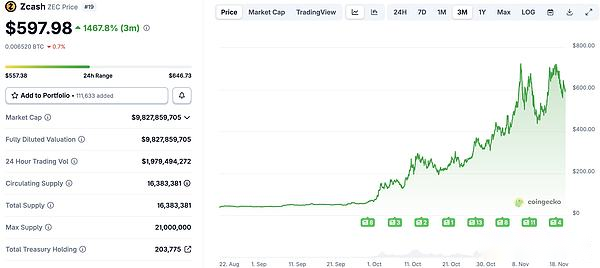
What pushed the mood to a climax was that a number of top tycoons took to the stage: @naval, @0xMert, Arthur Hayes and other heavyweights’ orders became a catalyst, detonating market FOMO and attracting a large number of KOLs, retail investors and even some funds to re-examine this old chain.It is rare that both Chinese and English CTs are enthusiastically discussing ZEC, privacy narrative and the resurgence of ZK technology. Privacy seems to be once again regarded as the protagonist of the “next big trend” by the encryption market.
However, against the backdrop of this seemingly hot and perfect narrative, some key fundamental issues have always been ignored:Are ZEC’s miner economic model, network security and on-chain interaction activity really enough to support an FDV worth more than 10 billion US dollars?
ZEC is on the eve of the typical Hardware-Price Scissors in PoW history
Before discussing the sustainability of any PoW project, the economic incentives on the mining side often most intuitively reflect the value capture capabilities of the chain.
Let us first calculate ZEC’s current payback period:
1) Z15 Pro: currently the most mainstream mining machine
The latest ZEC flagship mining machine that is currently the most discussed in the market and that miners are willing to snap up is the Bitmain Antminer Z15 Pro. Its hardware specifications are as follows:
-
Hashrate: 840 KH/s
-
Power consumption (Power): 2780 W, actual operation is about 2560 W
-
Energy efficiency ratio: 0.302 KH/W
Currently, the official website only has Z15 Pro futures, which will be delivered in April 2026. The price is $4,999. Friends who can’t wait can also go to the black market to buy second-hand spot goods. The real price is about 5w RMB.
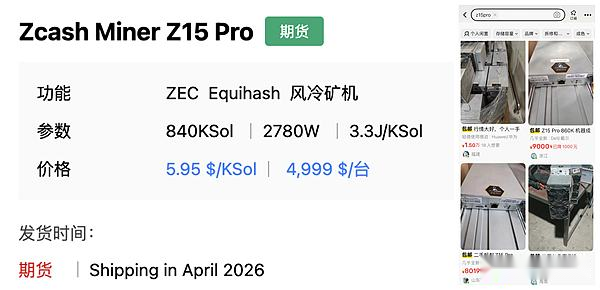
2) ZEC’s computing power and mining income structure: amazing daily income
In the past two months, ZEC’s high returns are rapidly attracting computing power to the market. The hashrate of the entire network has begun to grow significantly, and difficulty has also entered an increasing cycle.It can be clearly seen from the chart that the price of ZEC (yellow line) began to leave the sideways state at the end of September, and the hashrate (lavender) and difficulty (dark blue) subsequently increased simultaneously.This trend means that the mining side has begun to respond to the price increase.
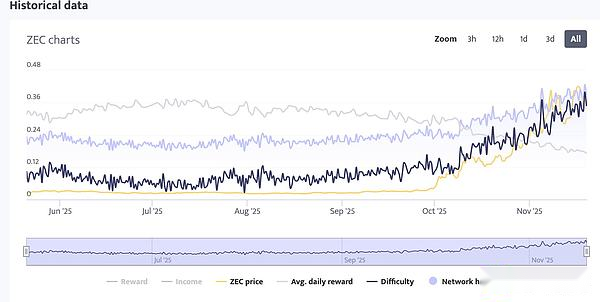
As of writing, the key parameters of the Zcash network are:
-
Computing power of the entire network: 13.31 GH/s
-
Network difficulty: 118.68M
-
Block reward: 2.5 ZEC/block
In order to calculate the daily profit, we bring the parameters of the Z15 Pro into the mining profit calculator and set it according to the standard miner settings:
-
Mining pool fee: 2%
-
Electricity price: $0.08/kWh
-
Daily electricity consumption: $5.34 (2.78 kW × 24 hours × $0.08/kWh)
Then we can come up with a surprising number:A single Z15 Pro nets over $50 per day!And judging from historical data, such high returns have lasted for at least one week.

3) Payback cycle: extremely rare high ROI
Assuming that the network difficulty remains unchanged in the short term and electricity costs are stable, we use the Z15 Pro mining machine futures price of $4,999 to calculate the payback period.
To reflect the true cost, here is the straight-line amortization of the mining machine over 5 years (1826 days):
-
Daily machine cost amortization: $2.74
-
Daily net income after amortization: approximately $47.63
Therefore, the static payback period of a Z15 Pro is only about 105 days, which translates into an annualized return of nearly 350%.
This number is extremely rare throughout PoW history—even an anomaly:
-
The payback period for BTC mining rigs’ rising cycle usually takes 12–24 months
-
The ROI of mining machines in the ETH PoW era is between 300–600 days
-
Historically, PoW projects (FIL, XCH, RVN, etc.) with a payback of less than 120 days almost all collapsed after a few months.

The current daily income of the latest BTC mining machine is ~$23, and the static payback period is about 3.4 years.
4) Case Review: The Repeated Hardware–Price Scissors
Hardware-Price Scissors is a “harvest” script that has been repeated in the history of PoW mining. When the currency price is the highest and the FOMO mood is the highest, the miners order the mining machine at a price several times the premium (the ROI seems extremely low at this time, and it only takes 4 months to pay back).However, when the mining machines are actually delivered and the computing power surges (usually with a delay of more than 3 months), the dealers often ship at a high price, causing the miners to face a double kill of “coin price cut in half + output cut in half”, and the mining machines in their hands instantly become high-priced scrap metal.
-
In May 2021, Chia triggered a global hard drive shortage.At that time, the price of XCH soared to $1,600, and the static payback period shown by early hard drive investment was once compressed to less than 130 days.This extreme profit instantly triggered a tsunami of global storage computing power.However, what followed was a tragic “scissors gap”: despite the decline in currency prices, the hard drives ordered in the early stage continued to come online, and the computing power of the entire network continued to skyrocket after the currency price peaked, and the payback period was rapidly extended from 30 days to more than 3,000 days.
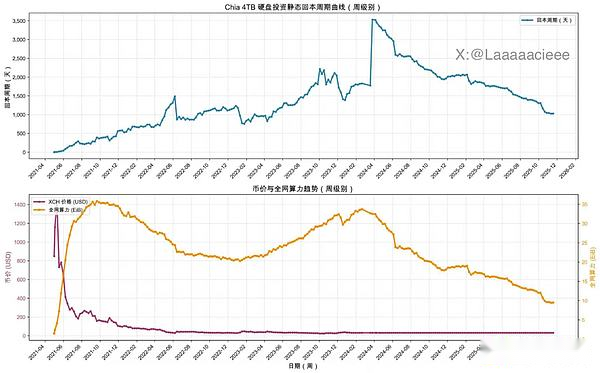
-
Observing the data of IceRiver KS1 mining machine, in mid-2023, its payback period was as low as 150 days.Unlike Chia, KAS’s coin price even maintained its upward trend.But even so, miners still lose money because the slope of computing power growth far exceeds the slope of currency price growth.The rapid iteration and large-scale deployment of industrial-grade ASICs have exponentially increased the difficulty of the entire network.Despite the strong currency price, due to the skyrocketing difficulty, the payback period of the KS1 machine has irreversibly soared to 3,500 days.
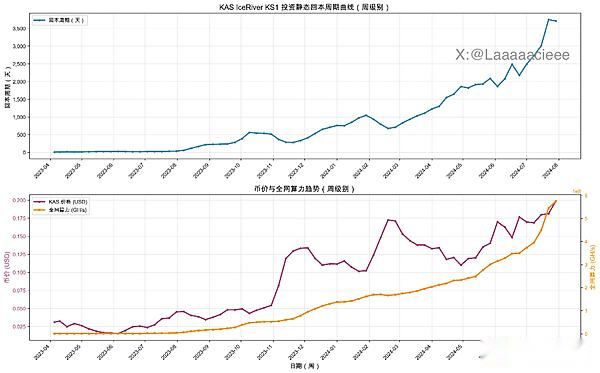
ZEC’s computing power level is in the danger zone of being attacked by 51% many times in history.
In addition to the mining economic model, another decisive risk line is the security of the network and the scale of computing power.For the PoW chain, “the scale of the entire network’s computing power + 51% attack cost” directly determines whether it can sustain itself under a high valuation.
1) The computing power scale of the entire network: only equivalent to a small and medium-sized Bitcoin mine
According to the latest data from the network, ZEC’s entire network computing power is approximately 12.48 GSol/s. Calculated based on a Z15 Pro computing power of 0.00084 GSol/s, only about 14,857 Z15 Pro mining machines are needed. The corresponding energy consumption is approximately 40 MW, which is equivalent to the size of a small and medium-sized Bitcoin mine.
Judging from the computing power scale of the entire network, Zcash’s security base appears to be extremely weak, and has entered the risk range of many small PoW chains that have been successfully attacked by 51%.
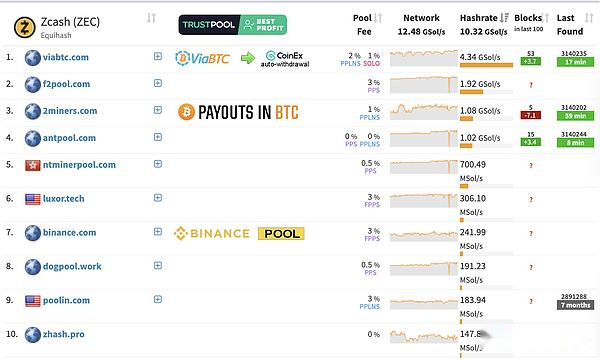
2) Attack cost: theoretically only in the millions of dollars
Generally speaking, launching a 51% attack requires mastering more than 50% of the computing power of the entire network at the same time.If nearly 1.60,000 Z15 Pros in the ZEC network can form the main force, then attackers only need to rent or purchase thousands of devices to control more than 50% of the computing power.
Rough estimate:
-
The futures cost of each Z15 Pro is ~$5,000. Generally, more than 300 units constitute a major customer purchase, and you can enjoy at least a 10% discount.
-
Control the computing power ~8,000 units → cost up to ~$40M, and the energy consumption required for the attack is about 20 MW
-
If leasing and second-hand prices are lower, the actual start-up cost may be millions of dollars.
On a public chain with nearly 10 billion US dollars in FDV, only a million-level investment in computing power can initiate potential chain reorganization or double spending, which itself is a structural risk that cannot be ignored.
3) Compared with mainstream chains: there is a huge security gap
In order to give everyone a more intuitive and clear perception, let us make a simple comparison with other large-scale PoW chains running:
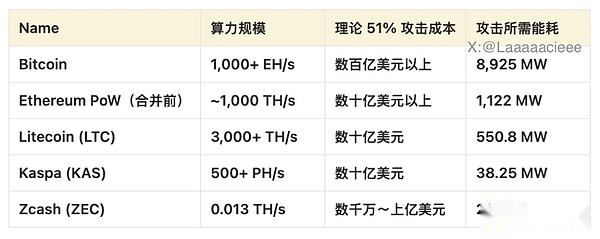
More importantly, ZEC’s current computing power is not only far lower than mainstream PoW chains such as BTC/LTC/KAS, but even ETC, BTG, VTC, and BSV, which have been successfully attacked by 51%, have generally higher computing power than the current ZEC when attacked. This means that ZEC’s network security has actually fallen into the dangerous range of being attacked.
On-chain data reveals ZCash’s real usage is still very limited
Although the ZEC narrative continues to heat up recently, on-chain data provides a more sober perspective – there is a significant deviation between real usage and the current tens of billions of FDV.
From transaction volume, active addresses to ecosystem size, Zcash’s actual network behavior is far less prosperous than price trends suggest:
-
The average daily transactions in the past month were only 15,000 – 18,000 transactions/day, which is only 1% – 2% of large public chains.
-
As a privacy chain, most transactions are still transparent transactions, and less than 10% of shielded transactions are
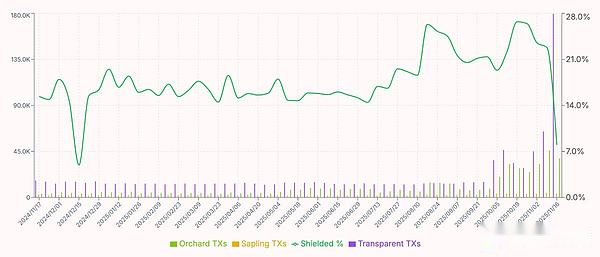
Repricing when the market returns from frenzy to calm
Narrative, emotion, celebrity effect and the economic trap of mining machines have combined to push an old project that has been dormant for eight years to the top of public opinion.But beyond the lively appearance, when we really return to the three core things of the blockchain:Economic Sustainability, Cybersecurity and On-Chain Adoption, ZEC presents a completely opposite picture.
This is:
-
The payback time is only 105 days and the annualized rate is 350%.
-
The computing power scale is only equivalent to a medium-sized Bitcoin mine, the 51% attack cost is as low as one million US dollars, the transaction volume is only 1%–2% of the mainstream public chains, and the actual use of privacy functions accounts for less than 10% of the PoW chain
History has proven countless times: extremely short payback cycles (ultra-high ROI) are often the precursor to mining disasters and currency price collapses.
Whether ZEC will be an exception, I cannot say.
But the rules of the crypto world have never changed:Narrative and emotion can create myths, but fundamentals determine how far the myths can go..






